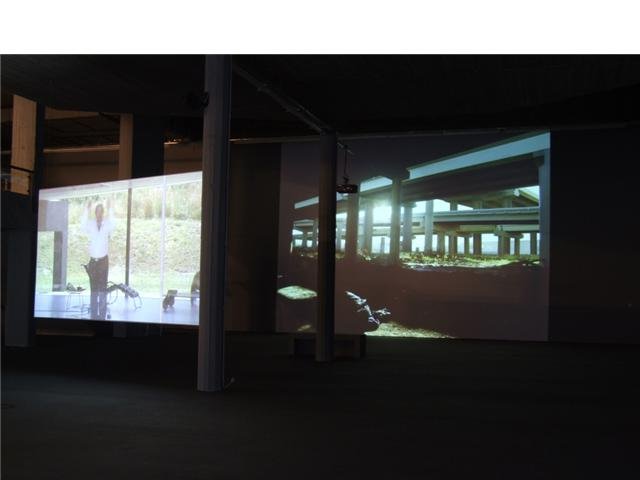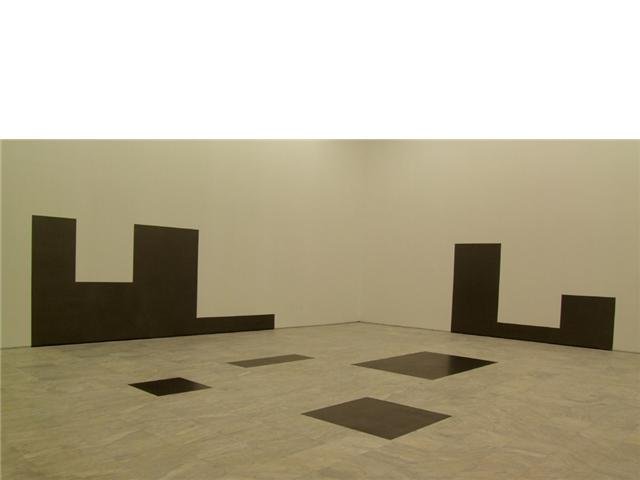David Claerbout / Ulrich Ruckriem
Reviewed by Leonidas Liambeys
⁰¹ David Claerbout, installation view at the Athens Conservatory, 2008
⁰² Ulrich Rückriem, Shadows of the Stone, installation view at the Athens Conservatory, 2008
Ulrich Rückriem is a sculptor of large, often monumental, stone forms. His work is represented here by six groups of drawings and a large drawing/installation. In the basement, the artist’s drawings (or minimalist sculptures as he refers to them) use layers of translucent paper, lines and blocks of graphite to build very thin works that function in series. There is a sense of pattern, craft and applied geometry at work here. The geometry, seriality, together with the three-tone graphite gray of the pieces, imbues these paper exercises with the seriousness and weight of the artist’s lifelong engagement with mass, rock and its geometric organisation. It is therefore a light relief to watch the accompanying videos of the artist talking about his stone sculptures. He refers to his influences (Brancusci, Rodin), his modernism and the viewer gets to see Rückriem draw, as well as see some of his larger pieces.
The installation upstairs (and the exhibition as a whole) is aptly titled Shadows of the Stones. This piece is comprised of another series of graphite blocks, this time drawn directly on the walls and floor of the room. These are the ‘projected’ shadows of a non-existent sculpture in the centre of the room — the ‘Stones’ — whose absence is marked by these forms. This compels the viewer to imagine the sculpture standing where they would be if their shadows were projected on to the walls by three imaginary spotlights. There is a sense of being immersed in an all-encompassing reverse orthographic projection, a technical drawing in three dimensions. Despite its minimalism and the simplicity of its means, the installation manages to create a sense of spectral absence. Furthermore, these marks are a trace of an original that may (or may not) exist. Is this Rückriem’s critique of post-modern simulacra or a Platonic allusion, in the form of a plea to the viewer, to try and (go and) see the stones themselves?
David Claerbout’s works explore time and space through photography, digital manipulation and are displayed on projected video screens. Sections of a Happy Moment, 2007, is a video 25 minutes and 57 seconds long. It consists of a slideshow of black and white photographs all of a single moment. They show a family together with a child’s ball forever suspended at the apex of its flight and modernist tower blocks in the background. As the slideshow continues, the viewer gets to see almost half an hour of the same instant from almost every conceivable angle and distance. Rather than bringing the viewer closer to the family at the centre of it all (as this example of complete surveillance may initially suggest), their forms become more and more impenetrable. The screen, on which the viewer sees this moment, becomes — through repetition — all the more present and material, as an increasingly ‘complete’ stereometric model of the family’s immobile surfaces is revealed.
Shadow Piece, 2005 (duration: 30 minutes and 19 seconds) is a digital game played out between an archival photo of a modernist building’s lobby and a burnt out ‘outside’ through its glass entrance doors. Periodically, people approach through the whiteness and try the doors. Only their shadows pass through the glass into the lobby. Slowly, the digital nature of these shadows becomes visible and the artificial composite nature of the picture becomes noticeable. The visitors can never get ‘in’, as the foreground is in fact an archival photo that the people (filmed in the artist’s studio) cannot enter. The empty lobby, a past moment captured in a still photo, remains inaccessible except as a playground for shadows. Time, the impossibility of overcoming it through digital means, remains at the centre of Claerbout’s work.
Bordeaux Piece, 2004, on the other hand, works with a 10–12-minute script that is repeated 70 times in the course of the film’s 13-hour-and-43-minute running time. Filmed by actors who become increasingly exhausted as the day wears on, the differences between each successive ‘performance’ are minimal. However, if the museum were open from 5 AM when the film is supposed to start, visitors would have the opportunity to see it in very different lighting conditions. Boris Groys is worth quoting in full here: ‘In the case of a video installation, a struggle arises between the viewer and the artist over control of the duration of the contemplation. Consequently, the duration of actual contemplation has to be continually renegotiated. Thus the aesthetic value of a video installation consists primarily in explicitly thematicizing the potential invisibility of the image, the viewers lack of control over the duration of his attention paid in the exhibition space, in which previously the illusion of complete visibility prevailed.’ (B. Groys, Art Power, 2008, p. 89)
Here the artist definitely has the upper hand over a hypothetical curious and extremely patient viewer: the impossibility of seeing the whole video is mentioned by Claerbout somewhat disingenuously (or perhaps rather cynically) in an interview with Daphne Vitali: “a real purpose of the piece was to show the most exciting parts that would never be part of the museum shows. In such a way, it is not only critique on film but also on exhibition making, in a sense. So, it’s best shown privately if you want … It’s best shown to the people who own the pieces.” (Claerbout to Vitali, 30 September 2008)
The museum itself as a frame, a single space that allows objects from different times and movements (in this case modernist and postmodernist) to be compared and investigated, is indeed critiqued through Claerbout’s impossible (to watch) video. However, rather than undermine the museum to the benefit of the market/owner, these works may in fact show what it is a museum can offer right now.
Instead of giving something extra to the potential ‘owner’ of a 13-hour video piece, it is only in a museum that such a work is recognised at all. Only there is that very impossibility — in the sense of not visible, or invisible — an object; an object observable through the gap that opens up between the work itself and what the viewer can possibly see.
In so far as both Rückriem and Claerbout deal with this invisibility in their own ways, these exhibitions offer a coherent opening for EMST in this new temporary space. Perhaps, there is something all right after all — something that can actually offer a degree of freedom — in seeing shadows of sculptures and videos, something that is not merely the symptom of being an art institution on the periphery of Europe. Perhaps, this is not something to fear but to embrace and push ‘contemporary, post-digital curatorial practice’ to its limits, to be bold, especially here, on the margins.
It’s also worth noting that the National Museum of Contemporary Art (EMST) is now temporarily housed in one of Athens’ many under-used public buildings: a ground-floor corner and several spacious basement levels of the National Music Academy (Odeion Athinon). It is an inspired find for the museum after years of uneasy cohabitation in the gilded halls of the Megaro Mousikis. The Odeion’s porticos have become a semi-abandoned marble skate park that now have a sculpture (Vadim Zakharov, Blackbirds) and security guard, and — if all goes well — quite a few more visitors. The interior is an uplifting experience of raw concrete walls and soaring beams, the high ceilings veined by industrial air-conditioning and, lower down, the white walls that are the semiotic uniform of most contemporary museums and galleries. There is also a wonderful dark unfinished concrete cinema/auditorium — a space the discovery of which makes one wonder melancholically what this hall has been used for over the last 30 years?

